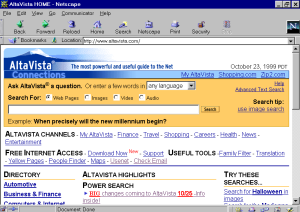Remembering Alta Vista — ‘high-speed’ search for the early Web
It was the go-to search engine of the early Web, and it was launched 20 years ago today.
 The pioneer was Alta Vista, and its technology of using spiders to crawl and index the Web was an element of the gee-whiz marveling that sometimes greeted the emergent digital landscape of 1995.
The pioneer was Alta Vista, and its technology of using spiders to crawl and index the Web was an element of the gee-whiz marveling that sometimes greeted the emergent digital landscape of 1995.
Wired magazine recalled the gee-whiz vibe in July 2013 when Alta Vista, by then a mostly forgotten product of Yahoo, was about to be put to rest.
“You made us go ‘woah’ when you arrived,” Wired said in reposting a tribute to Alta Vista that first appeared at Search Engine Land. “You did that by indexing around 20 million web pages, at a time when indexing 2 million web pages was considered to be big. …
“You grew in popularity. In fact, I’d say you were the Google of your time, but it would be more accurate to say Google was the Alta Vista of its time. That’s because Google didn’t even exist when you were ascendant. That’s also because you help paved some of the way for Google.”
Alta Vista was released when the Web was entering mainstream consciousness, an emergence examined in my latest book, 1995: The Year the Future Began.
In 1995, I write, “the Internet and the World Wide Web moved from the obscure realm of technophiles and academic researchers to become a household word.” It was “when the Web went from vague and distant curiosity to a phenomenon that would change the way people work, shop, learn, communicate, and interact.”
It was, of course, a time before Facebook, Twitter, Wikipedia, and ubiquitous WiFi. Google, I note in 1995, “was barely on the horizon: its founders, Sergey Brin and Larry Page, were graduate students who met in 1995 on the campus of Stanford University.”
Describing the emergent digital landscape in accessible terms posed a challenge for journalists, and a quaintness edged into their explanations.
Early in 1995, for example, the New York Times said the Web was “a section of the Internet overflowing with sights and sounds.” Near year’s end, the Times reported that the Web had become “a full-fledged media star, hailed and hyped, part technology and part fashion accessory.” At about that time, the Philadelphia Inquirer referred to the Web “an electronic publishing service for pictures, sound and video, as well as text.”
Some of that quaintness could be found in the Times report 20 years ago this week about Digital Equipment Corporation’s release of Alta Vista. The search engine, according to the Times, was “a high-speed system for finding information on the Internet’s rapidly expanding World Wide Web multimedia service.”
The Times article also said:
“It is expected that Alta Vista will draw large crowds to Digital’s Web site and act as a showcase for Digital’s own Internet products.”
 And therein lie a source of Alta Vista’s eventual decline. Although it was much-used and even beloved in the mid- and late-1990s, its trajectory was marked by neglect, takeover, vigorous competition, and obscurity.
And therein lie a source of Alta Vista’s eventual decline. Although it was much-used and even beloved in the mid- and late-1990s, its trajectory was marked by neglect, takeover, vigorous competition, and obscurity.
The tribute addressed to Alta Vista, written in 2013 for Search Engine Land and reposted by Wired, noted that Digital Equipment “didn’t quite know what to do with you. You started out as an experiment, and then got used as a poster child for Digital to prove why companies should buy super-computers.”
Digital Equipment was acquired in early 1998 by Compaq. Four years later, Compaq sold Alta Vista to CMGI, which planned an IPO for Alta Vista in 2000 but called it off amid the dot.com bust.
Alta Vista was sold in 2003 to Overture, which later that year was acquired by Yahoo. In July 2013, Yahoo pulled the plug on Alta Vista.
Its promise had long since evaporated: Google and its innovative page-rank system eclipsed Alta Vista by 2001.
More from The 1995 Blog:
- Prediction of the year, 1995: Internet ‘will soon go spectacularly supernova’
- ‘1995 was watershed moment,’ Intel’s CEO says
- Recalling the quaint early struggles to describe the Web
- Recalling the ‘coolness’ of the early Web
- The ‘Netscape Moment,’ 20 years on
- Illuminating the Web: Netscape’s IPO of August 1995
- How important was Netscape?
- 20 years after its launch, Amazon showing an unlikable side
- Anniversaries, controversies for Amazon.com
- Spoofing her majesty in the ‘Great Royal Phone Embarrassment’ of 1995
- Why 1995?

Pingback: Christmas and cyberspace, 1995: Toe-dipping online | The 1995 Blog
Pingback: Looking back at a watershed year: 1995 in blog posts | The 1995 Blog
Pingback: Beyond impeachment: The penalties Bill Clinton paid | The 1995 Blog
Pingback: Lewinsky affair, begun in 1995, hovers over presidential campaign 21 years later | The 1995 Blog
Pingback: 22 years after, ‘Newsweek’ takes red pen to flawed Internet column | The 1995 Blog
Pingback: Re-reading Clifford Stoll’s 1995 Internet predictions: Bah! | The 1995 Blog
Pingback: When the Web was new: Remembering Netscape and its fall | The 1995 Blog
Pingback: Clinton impeachment looking better, 20 years after | The 1995 Blog
Pingback: How AltaVista, our first steady search engine, fell into the digital abyss - JellyEnt
Pingback: How AltaVista, the principle correct search engine, fell into the digital abyss - JellyEnt
Pingback: Whatever Happened to AltaVista, Our First Good Search Engine – Bonewar
Pingback: Whatever Happened to AltaVista, Our First Good Search Engine – Shirley Coyle